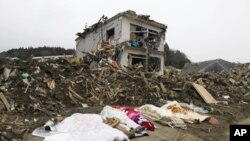While no two natural disasters are exactly the same, Indonesia's experience in recovering from its 2004 tsunami may provide some lessons for authorities and assistance organizations grappling with the natural disaster that struck Japan. The tsunami that hit Indonesia's Aceh province killed more than 160,000 people.
For Kuntoro Mangkusubroto, the dramatic footage of the destruction caused by the March 11 tsunami that inundated the coast of Japan brought back memories of the days following the 2004 Indian Ocean tsunami that killed more than 230,000 people in 11 countries. Two thirds of those died in Indonesia's Aceh province.
"What happened after the tsunami hit is a total, complete chaos. Nobody knows what to do. The local government is not functioning well. Everyone [wants] to help, then you don't know where to go," Mangkusubroto said.
He was the head of Indonesia's Reconstruction and Rehabilitation Agency that was formed four months after the tsunami hit Indonesia. The nuclear crisis in Japan makes humanitarian relief efforts there vastly different in some ways. But Mangkusubroto says Indonesia also had to deal with special conditions that hampered recovery efforts.
Aceh was dealing with an ongoing armed insurgency and the region was under martial law and was off limits to all foreigners, including aid workers, non-governmental organizations, and journalists. Mangkusubroto says what helped bring order to the chaos was the creation of a recovery agency with the mandate and authority of the president to override regulations and coordinate assistance.
"Once the agency is there, then everything is coordinated well. Quote, unquote. Why did I say that because the coordinating agency is also a new agency. Then, nobody had an experience in such a, what do you call it, a disaster of this magnitude," he said.
Mangkusubroto says the recovery process in Aceh, like the one now underway in Japan, starts with search and rescue operations, providing food, water, medical care, and temporary shelter for the survivors. It took Indonesia four years and more than seven billion dollars to rebuild homes, businesses, roads, schools and hospitals in Aceh. Much of the funding came from international assistance, and Mangkusubroto says he does not think any one country can recover from a disaster of this magnitude without help.
How long it takes to recover from the trauma of surviving a tsunami, he cannot say. In some ways, the people of Aceh may be forever scarred. While Adi Satria seems happy and carefree playing football with his friends, when asked about the tsunami he becomes withdrawn.
He says it is traumatizing to remember because he lost a lot of close friends.
The remnants of the tsunami damage have now become both tourist attractions and memorials. Khadijah from the city of Medan visited the wreckage of a hospital and a mass grave and reflected on the tragedy.
"No matter what you do there is another power beyond the human beings," Khadijah said.
But with time and support people do recover and begin again. Mangkusubroto says he had to relent on an order forbidding the rebuilding of homes near the sea, because he could not prevent fishermen from returning to their traditional way of life.
"Then I realized that if I pushed them to the hills and make this a red zone area, ok, I am doomed to fail because I cannot, what do you call it, stand against this opposition from the people," Mangkusubroto said.
He says a final lesson he learned is that while you cannot force people to relocate, you can minimize casualties from a future tsunami - by putting in early warning systems, erecting tall reinforced emergency buildings in vulnerable areas, and always being on the alert.











